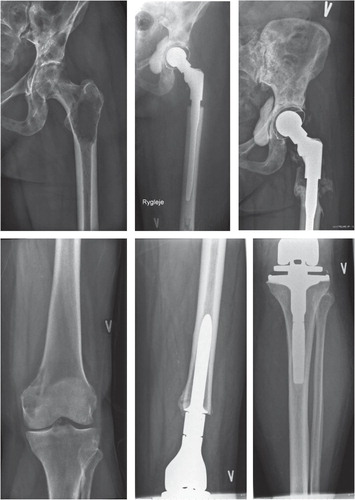Figures & data
Descriptive data for 130 patients who had 140 joint replacements because of metastatic bone disease during the period 2003–2008
Figure 1. Upper panels. A patient suffering from breast cancer and left hip pain because of multiple osteolytic metastases of the left hip and acetabular region (left panel); postoperatively, after resection of the proximal femur and insertion of a total hip replacement using an MP reconstruction hip stem (middle panel) and status 4 years later (right panel).
Lower panels. A patient with previous cancer of the bladder, suffering from knee pain because of a solitary metastasis of the medial femoral condyle (left panel); status 4 months postoperatively after resection of the distal femur and reconstruction with a GMRS prosthesis (middle and right panels).

Figure 2. Cumulative survival rate (solid line) and 95% confidence interval (dotted lines) for 130 patients who had 1 or more joint replacements because of metastatic bone disease during the period 2003–2008.

Figure 3. Cumulative survival rate (solid line) and 95% confidence limits (dotted line) for all 140 joint replacements inserted because of metastatic bone disease during the period 2003–2008. The probability of survival was calculated with either all kinds of surgery of the affected joint (left panel) or removal of at least 1 prosthetic component anchored to bone (right panel) as endpoint in the Kaplan-Meier analysis.
